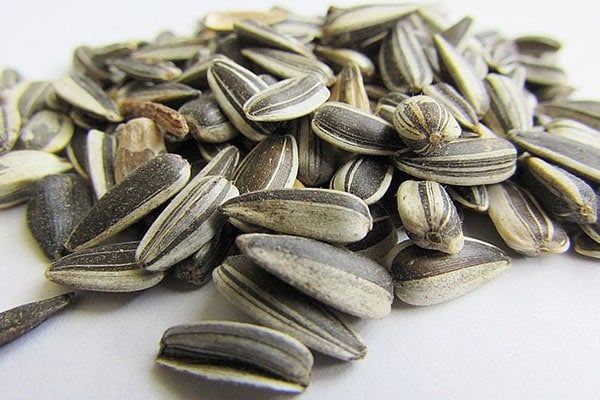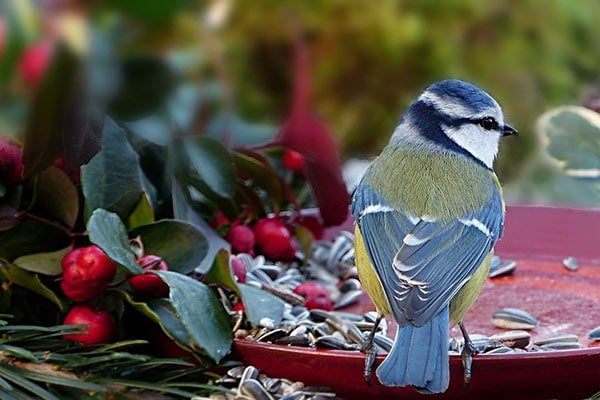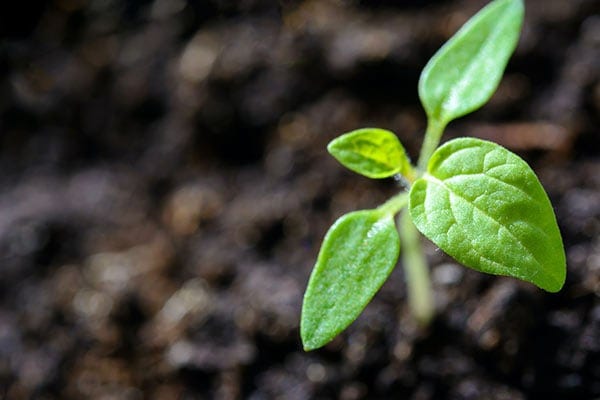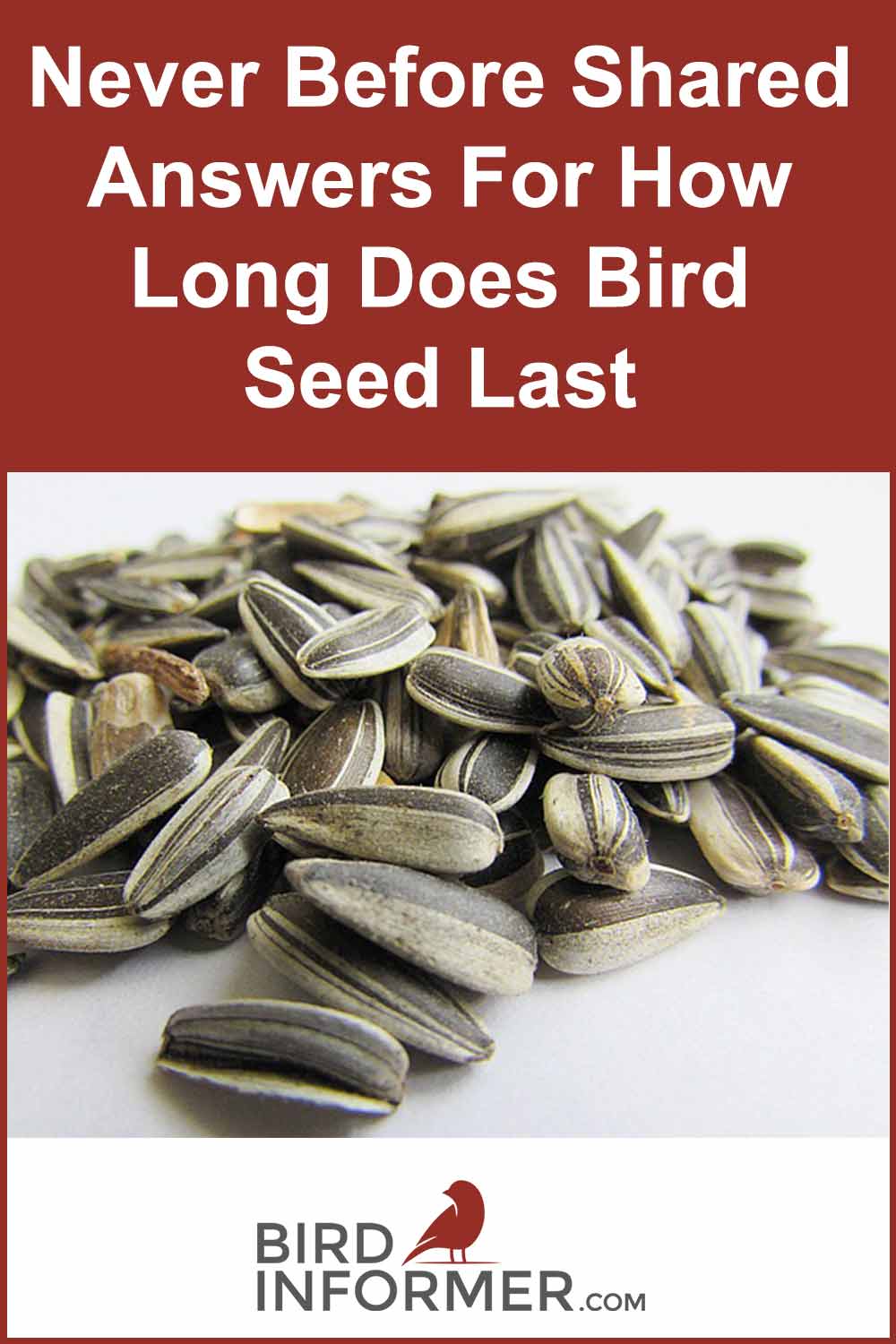Contents [show]
The most famous bird foods claim their bird seeds have a two-year shelf life. That much time seemed excessive to me, so I put on my detective cap and decided to do some sleuthing. I love wild birds and wouldn’t want to unintentionally harm them, which is why I scoured the web to discover the truth for “how long does bird seed last” and I’ll share it with you now!
Bird seeds last for 6-12 months with proper storage. Store the seeds in a cool, dry place to preserve maximum freshness. Only store bird seeds outside during cold weather months. Change the bird seeds in your feeders every 5-7 days or sooner. Check for mold, bugs, and bacteria to prevent rancidity.
And we’re just getting started…
I have so much more to share with you today.
Stick around to learn more about:
- Why 6-12 months is a safer expiration date range
- What happens to bird seeds after two years of storage
- How to test bird seeds for freshness with the cracking method
- Using the sprouting technique to test for freshness
- Determining bird seed freshness with the mold and smell test
Are you ready to learn these never-before-shared secrets?
Let’s dive right in then.
6-12 Months Expiration Date Range: The Safest Length To Store Bird Seeds

You may not know this, but you can typically find an expiration date range stamped on a birdseed package.
Really?
Yes, it isn’t always easy to see, but the expiration date stamp is there.
More often than not, the manufacturers will tell you the birdseed has a two-year shelf life. After two years, these seeds tend to lose their potency.
Even worse, after sitting for so long, they may eventually start to go rancid. This is especially true if you store your bird seeds incorrectly.
Here’s my thought process:
Although companies certainly want to provide high-quality products, they also have to keep their bottom line in mind.
The last thing they want is for pet stores and online retailers to start shipping stale products back after 6-12 months. It isn’t very good for their financial health.
And it’s the real reason why I believe they stamp a two-year expiration date on their products.
Related article: Buyers Guide To Finding The Best Bird Seed
The Foremost Reason To Ignore Two-Year Shelf Life Claims
Birdseed companies aren’t lying or sharing false information by any means.
But, if you buy bird seeds nearing the two-year expiration date, they aren’t nearly as fresh and their vitamin and mineral potency is severely diminished at this stage.
In my expert opinion…
You’re doing your backyard birds a great service by feeding them the freshest and newest bird seeds you can find.
Because let’s face it…
Even though manufacturers package their bird seeds in nitrogen gas, which is capable of preserving nutrients, there’s too much that can go wrong during the packaging process.
And what are you left with?
More than likely, you’ll have foul or rancid seeds on your hands. Or at best, you’ll have pounds of bird seeds that no longer possess the nutrient content needed for healthy backyard birds.

Two Years Later: What Really Happens To Bird Seeds After Storing Them For Two Years Or More
Picture this:
You find a brand-new bag of black oil sunflower seeds in your basement but it’s covered in dust. After wiping it down, you realize that these seeds expired about three years ago.
A thought crosses your mind:
“What happens if I feed three-year-old sunflower seeds to my favorite wild birds?”
Well…
First off, by now the seeds may be spoiled. Open up the package and take a look around.
Ask yourself…
- What do I see?
- How do these seeds smell?
- Does it look like mold is growing on the seeds?
- Do the seeds look fresh?
In many cases, these seeds will look completely fresh even though they’ve sat around in your basement for the last three years.
This will tempt you to feed these old seeds to the birds in your backyard.
Guess what? This is a bad idea.
On the one hand, I’d like to tell you that feeding old seeds to birds shouldn’t harm them in any way, shape, or form. This is true as long as the bird seeds look healthy and unspoiled.
According to Be Chewy, “After two years, the embryo and the endosperm in the seeds have probably dried up and died.”
So…
These seeds likely possess zero nutrients at this point. And feeding birds seeds that are completely devoid of nutrients is like feeding them filler.
Sure, it will fill them up and stuff their little bellies. But it isn’t going to provide them with the nutrients and energy that they need to lead healthy lives.
So, avoid feeding the birds expired seeds. They possess no nutritional value and the birds will likely ignore them anyway.
The Cracking Method: An Effective Way To Examine Bird Seeds for Freshness
I bet you didn’t know that you could crack open bird seeds to find out if they’re still fresh. I didn’t know this was possible either until I recently learned about this method.
Here’s what you do:
- First, crack a seed open. If it has a hard shell, remove the hull so you can get to the meaty center of the seed.
- Second, take the meaty heart of the seed and squeeze it. Squeeze as much as you can to check for freshness.
- Third, as you squeezed the seed, did you notice if any oil came out. Check to see if there is any oil on the seed or your fingers.
The oil is the key to success with this method. If oil is present, it will tell you that your seeds are still very fresh. This is a surefire sign that the seeds contain plenty of life-giving nutrients.
On the other hand:
Did you squeeze the seeds and no oil came out? This basically tells you that it isn’t good. It has completely dried out at this point and it doesn’t possess any nutritional value, which ultimately makes it birdseed filler and nothing more.
The Sprouting Technique: Another Foolproof Way To See If Bird Seeds Remain Fresh

Next, it’s possible to test freshness by attempting to sprout a handful or more of your bird seeds to see what happens.
Why does this process work?
Simply put, this technique is pretty simple to follow.
The steps include:
- Get a paper towel and dampen it with water.
- Take the damn paper towel and wrap 20 seeds within
- Keep the seeds wrapped for a total of 3-5 days
- Make sure the towel remains damp for the entire time
And once you’ve waited the requisite amount of time…
It’s time to check your results.
Basically, you’re trying to determine how many seeds have sprouted in the paper towel.
Remember, you started by attempting to sprout 20 different seeds. If 15 seeds sprouted during the necessary sprouting period, you have a 75% germination rate.
This rate is good and it tells you that the bulk of your seeds are still fresh. This means you can safely feed them to your birds.
Or…
If only 5 seeds out of 20 sprouted, you only have a 25% germination rate. This is too low because it means the bulk of the seeds has gone bad.
It’s time to discard these rotten problem seeds.
The Mold & Smell Test: A Simple Way To Determine Bird Seed Freshness
Lastly, it always makes sense to perform a mold and smell test.
When testing for mold, you should open up the bag of seeds and look closely for mildew and mold. As we all know, these corrupt substances can actually be deadly to birds. The mold leads to fungus growth and potential death.
As you examine the seeds, pay close attention and notice if they are giving off a musty smell. Do they have any discoloration? Is fungus visibly growing on them?
If you answered yes, then your seeds are moldy, and they need to be discarded.
And another thing about mold…
Do your seeds have a slimy feel to them? If they are slimy, this means that mold spores are present. Do not feed mold spore-filled seeds to your favorite backyard birds.
And let’s not forget about the smell test.
A wide range of seeds contains healthy amounts of oil. Believe it or not, these oils will generate a rancid smell after they begin to go bad. This is essentially the musty odor that I referenced earlier.
Do you notice a rancid, sharp, musty smell? More than likely, your seeds are moldy and spoiled. You should get rid of them right away and never feed them to the outdoor birds.
The Final Word On How Long Does Bird Seed Last
We just learned that bird seeds remain freshest for 6-12 months. When packaged properly in nitrogen gas, the manufacturers claim they can last up to two years.
Personally, I feel it’s better to remain safe than sorry. Even though 3-year-old birdseed isn’t necessarily harmful to birds, they aren’t very helpful either. They contain zero nutritional value and provide the same lack of substance as birdseed fillers.
It’s best to avoid giving your backyard birds old and stale seeds. Instead, perform the cracking method, the sprouting technique, or the mold and smell test to see if they are still fresh.
Did they pass the test? Good!
Never let your seeds go to waste and get out there and feed them to your favorite wild birds right away. Because we now know that your bird seeds won’t last forever!
Related Articles:

